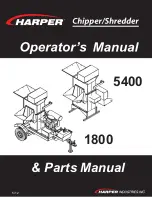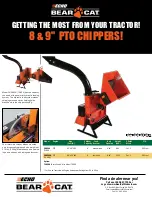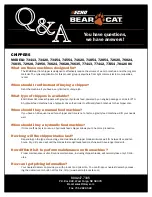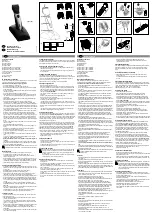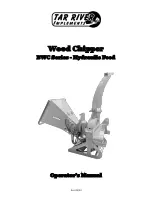
Bandit
Copyright 1/10
PAGE 8
MODELS 65XP(XL)/95
SAFETY PROCEDURES
It is very important after you have operated a new
machine for approximately an hour to shut down the
machine and recheck all nuts and bolts. It is normal
for nuts and bolts to loosen once on a new piece of
machinery. If you tighten them now, there is a good
possibility they won’t loosen again. Certain nuts and
bolts should be checked periodically such as anvil and
knife nuts and bolts, etc. for torque and fit.
Most of the nuts used on the machine are self locking.
After a nut or bolt has been removed five times, it
should be replaced to insure proper tightness. This is
especially critical on the chipper knife nuts and bolts!
After the engine is started, let the chipper disc/drum
turn at the lowest RPM’s possible. Listen for any type
of noise that is foreign. Any steel on steel noise is
foreign. If you hear a noise, stop the engine, find the
problem and fix it.
SAFETY PROCEDURES
Never reach into the infeed hopper area of
the machine, there is never any reason to. The
feedwheel(s) are designed to pull trees and brush of
any length into the machine. Pulling a hand, arm, foot
or entire body through the machine is much easier
than pulling a tree. Do not think you will be able to
pull yourself free of the feedwheel(s), they will not let
go. There is absolutely no reason to work inside of the
infeed hopper. If the feedwheel(s) become tangled or
clogged, stop the machine and wait several minutes
before cleaning them out. If there are short pieces, or
leaves and twigs, just leave them until feeding longer
pieces. While the long pieces are feeding, simply toss
the short pieces on top of them. The longer pieces will
take them on into the machine.
A wooden push paddle has been provided to assist
in feeding smaller material. It is the owner’s and
operator’s responsibility to use and keep a wooden
push paddle with the machine and to also secure it
when transporting the machine. DO NOT use any body
parts or any steel devices inside the infeed hopper
area.
If there is larger diameter wood, try to feed it with
smaller diameter wood. Start a small diameter limb
which will partially open the feedwheel(s). Once the
feedwheel(s) are partially open it is much easier to
insert the larger diameter wood.
When feeding larger diameter wood, listen for the
engine to possibly lug down. If it starts lugging down
stop the feedwheel(s) by pushing the hydraulic control
bar to off, and let the engine recover to full speed. If the
machine is equipped with Autofeed and it is functioning
properly, the feed system will automatically stop to let
the engine recover. This will help stop the machine
from plugging the discharge chute.
Pay attention to the direction of the discharge chute
before chipping. Never stand in front of the chipper
discharge chute. Never direct the chute towards
anyone or anything that could cause an accident or
problems. Always stop chipping and warn anyone
that comes near the discharge area. Failure to do this
could result in severe injury. Wood chips flying out of
the discharge chute can be very dangerous!
NEVER sit, stand, lay, climb or ride anywhere
on this machine while it is running, operating, or in
transit. You will be injured.
Do not attempt to start the engine or engage the
engine PTO (power-take-off) system on this machine
if the chipper disc/drum is jammed or frozen in place.
If you do, you will damage or ruin the drive belts and/or
the PTO which will not be covered under warranty and
will cost you down time and money.
DANGER
DANGER
DANGER
WARNING
NOTICE
This chipper is designed to “HAND FED” only! DO
NOT feed wood with any type of knuckle boom loader,
front end loader, or mechanical device. It will cause
damage to the machine. If this happens, the machine
WILL NOT be covered under warranty.
WARNING
It is very important after you have operated a new
machine for approximately an hour to shut down the
machine and recheck all hydraulic fittings. Retighten
as needed.
DO NOT GO NEAR HYDRAULIC LEAKS! High
pressure oil easily punctures skin causing serious
injury, gangrene, or death. Avoid burns from fluid. Hot
fluid under pressure can cause severe burns. DO NOT
use fingers or skin to check for leaks. Lower load or
relieve hydraulic pressure before loosening fittings.
Relieve all pressure in the system before disconnecting
the lines, hoses, or performing other work. Use a piece
of cardboard to find leaks. Never use your bare hands.
Allow system to cool down to ambient temperature
before opening any coolant or hydraulic oil system.
In cold weather situations let your hydraulic system
idle for approximately 15 minutes to allow the system
to warm up to operating temperature.
WARNING

























